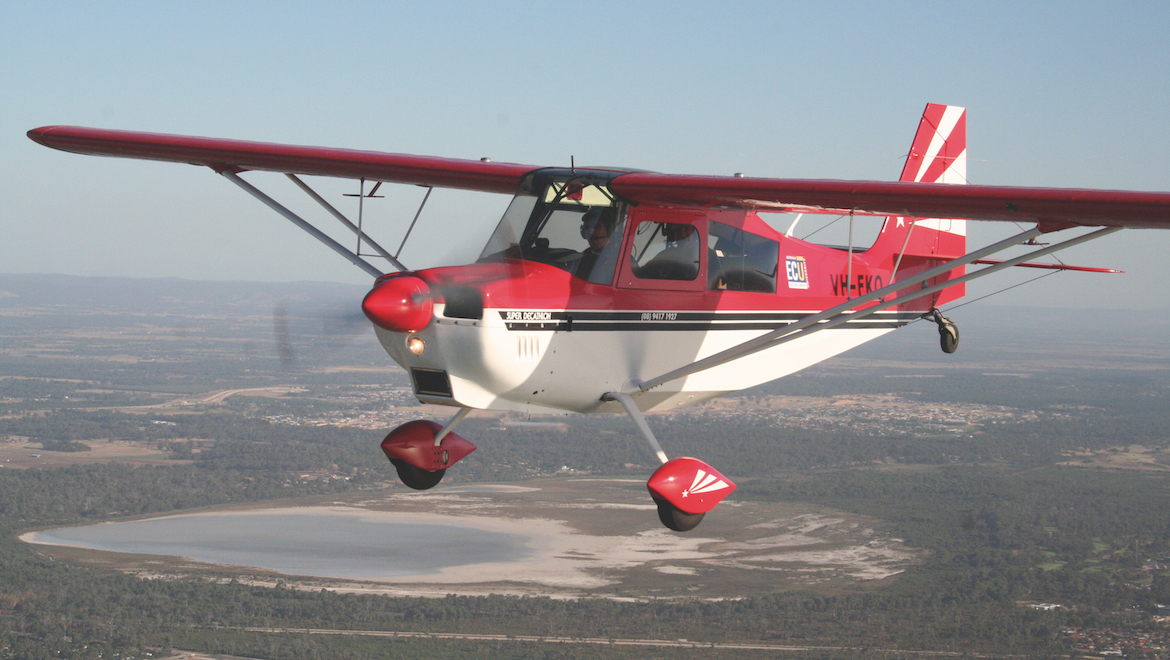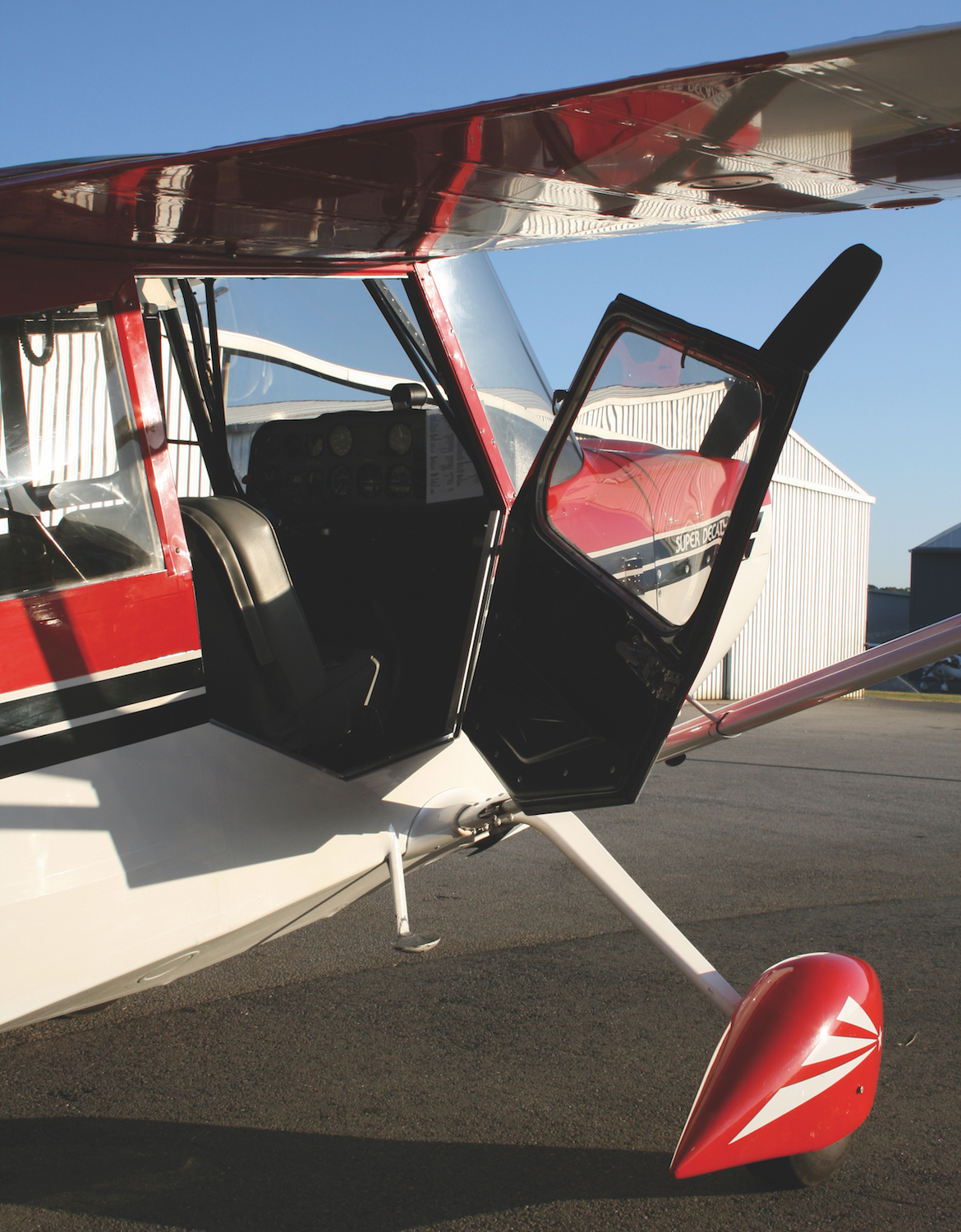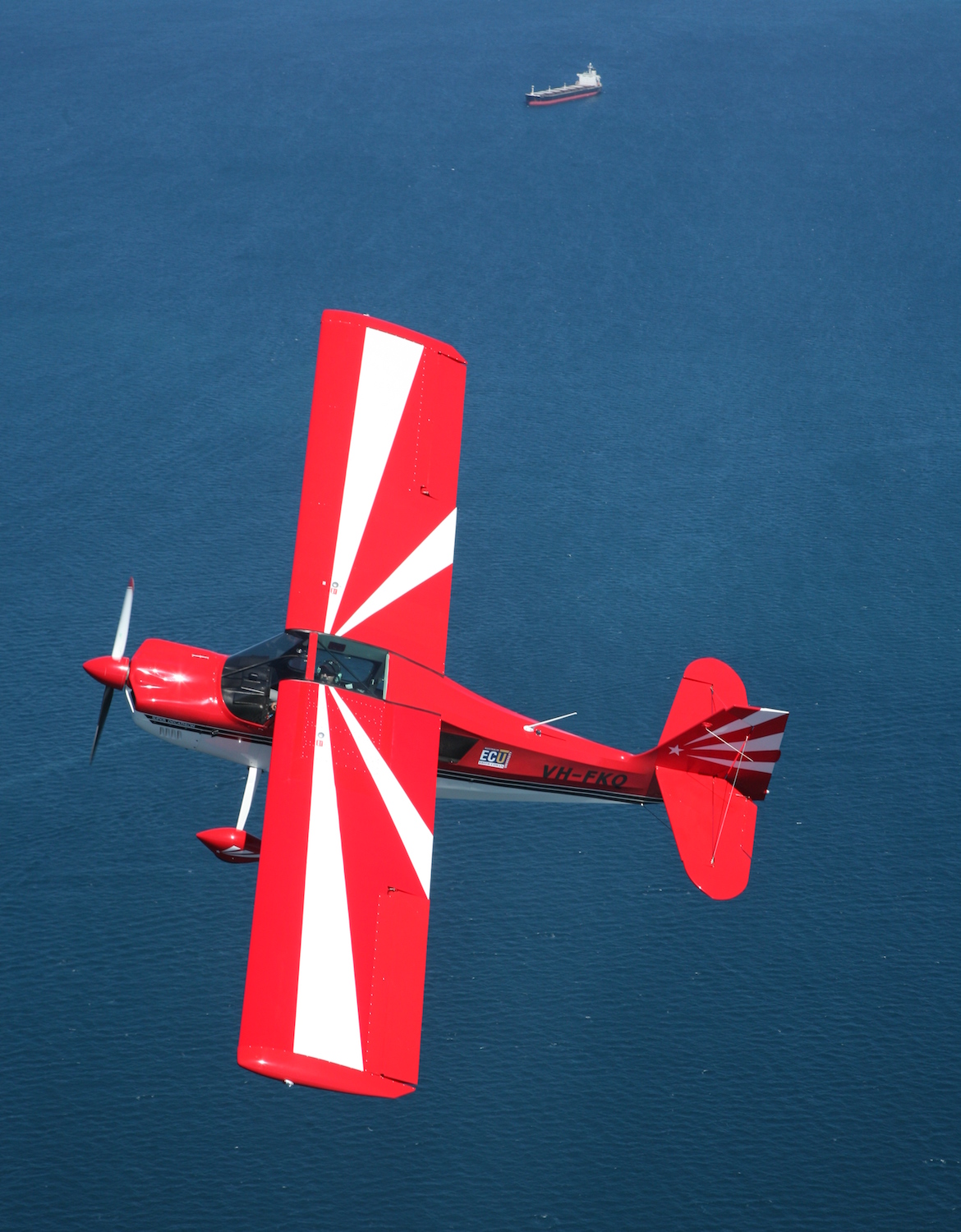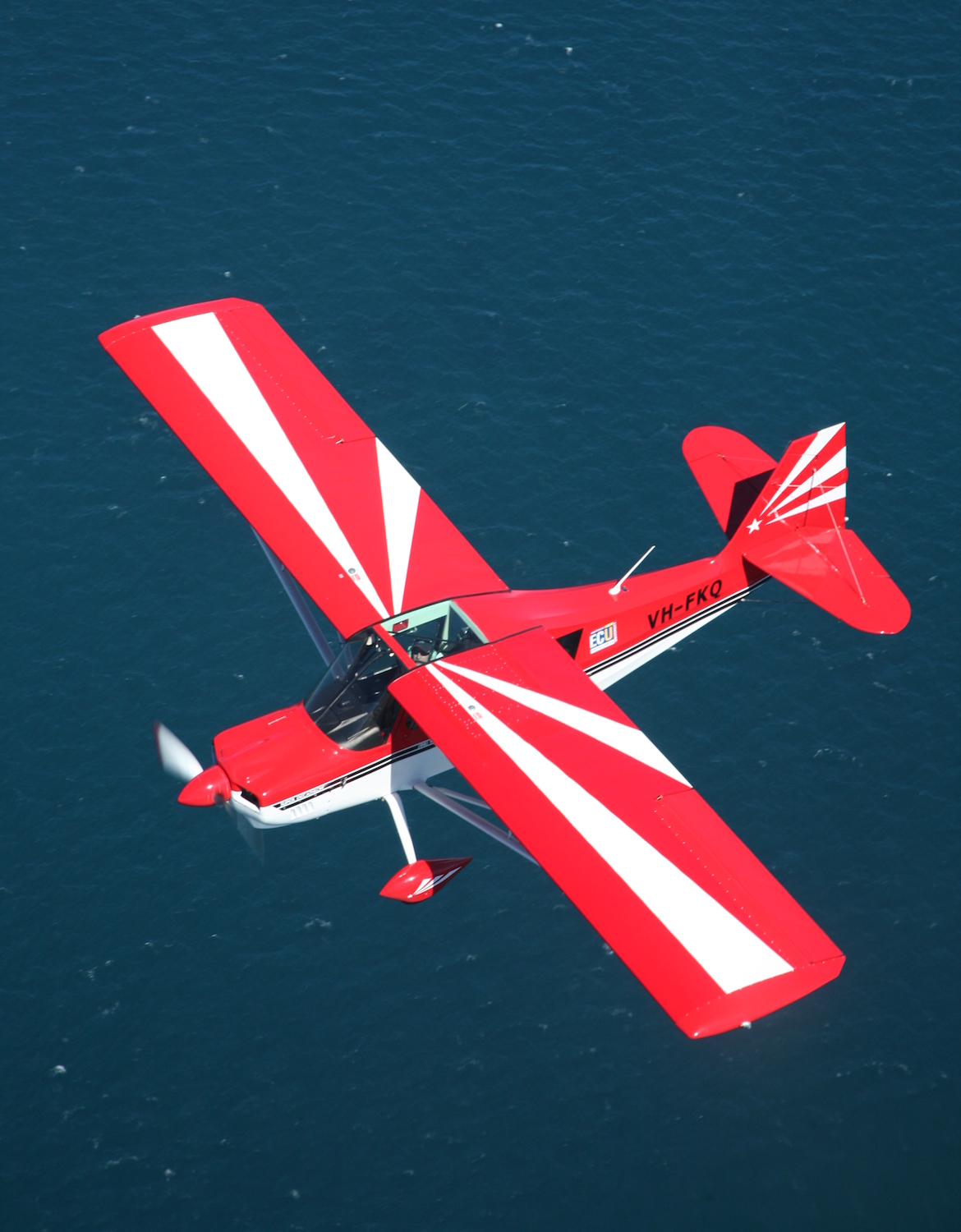This story from the Australian Aviation archives is from September 2009, when Bob Grimstead took the Super Decathlon on a flight test.

The latest iteration of a long line of trainers, tourers and load-haulers, this Super Decathlon traces its roots back 60 years to Aeronca’s minimalist Champ, although these days there is little commonality between that original low-powered lightweight and this muscular monoplane.
The all-metal Super Decathlon is very strong (stressed to + 6 and – 5G) and uses a semi-symmetrical NACA 1412 aerofoil on short span wings with strong, thick walled struts and aileron spades for decreased control forces. Gap seals, mass balances and generous control surfaces with large deflections give superb manoeuvrability. Its gutsy, 180hp (135kW), fuel injected Lycoming engine has fully inverted fuel and oil systems, with a constant-speed propeller to get the best from it. Seven-point Hooker ratchet-cum-secondary harnesses, a transparent roof and all the necessary allied equipment allow full-on aerobatics up to intermediate standard in the right hands.
And yet, the Super Decathlon retains its family’s attributes of predictable handling and excellent visibility both on the ground and in the air, a reasonable range at a fair cruise speed, and cross-country comfort. The cabin is very roomy for a two-seater, affording so much headroom you could wear a top hat, and a huge amount of space (a full cubic 0.25m3) in the back for at least a weekend’s luggage, with a liberal 45kg allowance. Moreover, the netted, 60cm long, full width and depth baggage area is easily accessible in flight.
Yes, just walking out with aerobatic instructor and all-round ace Jeremy Miller to this perky little red beauty with its dazzling high visibility paint scheme, I know we were going to enjoy ourselves – and boy, was I ever right!

Open the jettisonable car-type door, hop up on to the step, grab a windscreen bracing tube and pull yourself up into the well-padded seat. Look around: what a nicely appointed cockpit! There is a proper control column on the floor, cast rudder pedals with toe brakes, a throttle and alternate air quadrant where it should be on the left wall, with a similar elevator trim quadrant below. The propeller and mixture plungers on the lower left panel are close enough to the throttle that you can simultaneously adjust them with your fingertips – a nice touch.
At first glance it seems everything you could need is right in front of you on the low, wide but simple panel. Flight instruments in the middle, engine gauges on the left, radios on the right, it’s sensibly laid out. But where are the electrics? Aha, further investigation reveals another, smaller sub panel up over my left shoulder – well over my left shoulder – dislocatingly over my left shoulder! Here in the wing root are a row of switches and a clutch of circuit breakers, with the avionics master strangely separated from all the others. Fortunately, the magneto and master switches are at the front and not quite so far away, so I flip them to on.
Direct-reading mechanical fuel gauges are recessed into the wing roots, and easily scanned with a swing of the head, although they do significantly under-read in the tail down attitude. Now we come to the one slight disadvantage of this aeroplane. While its maximum takeoff weight in the normal category is 884kg, allowing a 177kg payload with full fuel, its aerobatic maximum weight is limited by a further 68kg to 823kg. Jeremy’s a big guy and I’m no featherweight, so we have to restrict the fuel load for our planned dedicated aerobatic sortie. Glancing at those gauges, I see they say we have half tanks as requested, so I twist the fuel selector low on the left sidewall to on to feed from both tanks simultaneously.

Starting the rugged Lycoming is quick and easy – with the mixture rich you give it a three-second prime using the electric boost pump, then bring that red knob back to lean, crack the throttle and clamp the stick back between your thighs. With your left fist holding the throttle, you press the separate starter button with your right thumb. Within moments the propeller is spinning, so you shove in the mixture and you’re alive. Squeeze its locking cap to push in the parking brake plunger below the right end of the panel and you’re on your way.
The tailwheel steers perfectly despite springs in its linkage, the brakes work well, manoeuvrability is excellent, and the forward visibility is superb for a tailwheeler despite a skinny central windscreen divider that is so unobtrusive you soon stop noticing it.
I can clearly view the taxiway ahead over that odd shaped, semi-angular cowling. This bodes well. The engine run-up is straightforward, as are our pre-takeoff checks. All we have to remember is the electric boost pump, used for takeoffs, landings and aerobatics, and it’s time to go.
Carefully lining up, I advance the throttle. The engine note is nicely throaty. Leading with a little right rudder, I am surprised by how easy it is to keep straight. After a couple of seconds I gently raise the tail (which takes quite a push on the stick) but we still run straight and true. With greater weight and a smaller wing than my accustomed Champ, and despite having more than double the power, it takes the Decathlon a little longer to become airborne, at around 60kt and after maybe 200m, but then it immediately out-performs any Champ by hurtling heavenwards.
The best climb rate speed is 70kt, and I time our brief full-power ascent at nearly 1200ft/min, despite the heat of a 30 degree day. At 500ft I throttle back to 25in and 2500rpm – 75 per cent power – but the VSI still reads over 1000ft/min, even at this reduced setting. Best angle of climb speed is a mere 50kt, and looking out at the wing tips you can see that this near-symmetrical wing section needs a high angle of attack to squeeze the maximum performance from it. To hold 50kt it is at nearly 20 degrees to the horizon!
Accelerating into an 80kt cruise climb, within five minutes we are at 5000ft and ready for action, just as the manual claims. It also says that this only takes you 6nm – nicely away from the aerodrome traffic zone but not too far to glide home. So many trainers take forever to get to playtime height that this is a refreshing plus.
Levelling while leaving the power at 75 per cent, our airspeed gradually creeps up past 100kt. The POH quotes 127kt as the high speed cruise, but that would be true airspeed, on a much cooler, ISA day and probably with the original metal Hartzell propeller. We have the optional and slightly more expensive wooden MT prop, which has advantages in flick-rolls and vertical penetration, as well as being a useful seven kilograms lighter.
Fuel consumption should be around 36 litres per hour, although most IO-360 operators approximate at 40 litres per hour for safety. The 148 useable litres tank gives us a four hour dry-tanks book endurance, although again three hours would be more sensible for planning with a margin. Of course, today’s aerobatic load of 75 litres still allows us an hour and a half of full on fun – more than enough for my fragile constitution.
Trimming forwards and letting go of the controls, I soon find that we can cruise hands-off, just like in any lesser machine. Rudimentary tests demonstrate that this aeroplane is highly stable in all axes. Our nose is well down below the horizon, and the panel’s top is low enough not to obscure anything, so I can see extremely well ahead as well as all around on both sides. Even our overhead is clearly visible, thanks to that transparent roof. The whole view is great, and if we wish, below 113kt we can swing out the bulged window on our left to photograph the world below. This is also useful for a little extra ventilation, which is otherwise not too great on such a hot day.

Quickly completing our HASELL checks and ratchetting my harness bar-taught, I start the fun stuff with a clearing turn each way, and am initially taken aback by the comparatively high control forces. I am surprised that, despite the aileron spades and generous horn balances (and probably mostly because of our significantly higher airspeed) all these controls are comparatively heavy, and certainly no lighter than a Champ’s. But the gap-sealed ailerons are much more effective, with only a little adverse yaw, and no sign of the wing flexing exhibited by the Decathlon’s longer winged predecessor. Even the mass and horn balanced elevator feels heavier than in that slower aeroplane.
I can see why the Super Decathlon has been designed and certified this way – even a ham-fisted Schwarzenegger couldn’t break it, but this is not really to my taste. I prefer daintier handling, although the controls are obviously powerful and effective. You just need both hands for big deflections. Gentle, medium and steep turns are all undemanding – I even manage to hit my wake a couple of times, despite spending most of the time swivelling my head to enjoy the excellent views through all those transparencies.
Now for a couple of stalls. Power-off, the nose nods neatly at 45kt (the book says 53mph or 46kt at top weight). Keeping the slip ball centred, there is no sign of a wing-drop – perfect and benign. Power-on, the result is the same, but at slightly over 40kt. In both cases there is a surprising amount of airframe buffet well before the break. Not many modern aeroplanes give such elemental warning of impending doom so, although it has one, the Decathlon really doesn’t need its bleating electric stall warner.
So far, so predictable; just like any modern, licensed, production aeroplane; but how does the Decathlon aerobat? First trying a simple loop, I note the heave required to get our nose up past the vertical, and use both hands on the stick – not just for keeping straight, but to overcome the pitch forces. The transparent roof is ideal for sighting our line feature – a straight stretch of dual carriageway highway below. After a couple more goes, I have the loop hacked, so it is not at all difficult, just heavy on the elevator.
An aileron roll comes next, and this goes much better. Pop the nose up 10 or 15 degrees above the horizon, check, hit full left aileron (not quite maximum bicep power is needed) and watch the world revolve in a little over two seconds. As we go through the inverted, our nose seems comfortably high, and I congratulate myself at having lifted it sufficiently beforehand, but as we swing through to erect, now it seems to have dipped well below the horizon. It turns out the Decathlon needs a surprisingly high initial pitch-up for a ballistic roll. This is of course a function of wing incidence and a by-product of that nose-low cruise attitude.
A slow (straight-and-level) roll also goes well, although I need more rudder to slew up our nose in the first quarter than I am accustomed to. A couple of repeats and this too becomes acceptable, with the dead-beat ailerons stopping it on the dot.
A stall turn to the left (with the propeller) also goes well, as does the half-Cuban eventually (not enough rudder again). To my surprise the half reverse Cuban turns out nicely at my first attempt – so I decide not to push my luck by repeating it.

Now for some vertical stuff, an area my low powered habitual mount can’t really aspire to. It would be nice to make a half vertical roll, topping it off with a stall turn. Jeremy says it’s feasible, so we’ll have a go. I push the trim lever a bit further forward to minimise residual elevator force in the vertical, and since our maximum level speed is just around 110kt we have to dive a bit for this one, but 160 soon comes up on the dial. Pulling hard to the vertical, I check, whack the stick against my leg, wait until we’re facing the other way and stop. What’s the speed? Dropping through 40 – we should be able to make it. I kick on full left rudder and pause. The nose takes a while to yaw around. We’re going a tad too slowly really, but patience (plus some forward stick and opposite aileron) is rewarded and we swing back through to the down-vertical.
That was great fun, so I do another. Okay, I didn’t quite get my verticals correct, nor apply enough right rudder in the climb, so our left wing dipped, but I’ve proved the principle, the Super Decathlon will fly a nice 180 degree vertical upward roll and stall turn with practice, even two-up and with its power limited by our altitude.
A couple more attempts bring clear improvements.
So how about some flick rolls? Again, this is no problem for the competent Decathlon, especially since this one has the lighter MT prop, minimising crankshaft stresses. I try the first strictly by numbers. Leaving the throttle wide open, I lift the nose to get our speed below 70kt, smartly lower it to fly level, quickly heave fully back on the stick, kick hard on the left rudder and immediately push the stick forward to near neutral. Around we snap, quick as you like, but I’m a bit slow on the recovery, so we end up left wing-low. Once again, a couple more attempts bring clear improvements.
What a great trainer this is! And how nice, thanks to that constant-speed propeller, not to have to worry about engine rpm or needing to throttle back with increased airspeed. This aeroplane gives you maximum available power (depending on altitude and temperature, of course) throughout your routine.
We leave our spins until last to get back down from 5000ft. The manual for older Decathlons contradicts itself, in one place giving the standard recovery of full rudder first, then elevator forwards, but in another place, suggesting you push the stick forwards before the rudder. I prefer the “standard” method, which Jeremy calls the PARE method (Power, Ailerons, Rudder, Elevator), an excellent acronym I hadn’t previously heard, so that’s what we do.
Reducing speed with the throttle closed in level flight, at 1kt before the stall I progressively apply full rudder, bringing the stick all the way back once the wings roll and the nose starts yawing earthwards. This comfortable, “semi-competition” entry gives a gentle transition into the spin while getting it stabilised as quickly as possible. After three-quarters of a turn we are in a steady state, so at two-and-a-half turns I apply the recovery inputs. Before the stick is halfway forwards, we are out of it and heading directly towards my home airfield of Serpentine. So it took precisely a half turn to recover.

The same happens in both directions, which is always nice. There is no sign of the engine faltering as might happen in some other competing types, and it shows once more just what a safe and predictable aeroplane this is. Now it’s Jeremy’s turn, and he shows me his party piece, a half upward vertical roll with a stall turn off the top, going straight into a full power, three-turn flat spin. What fun that is, with a lovely gentle progression between each component of the figure and very little in the way of G-forces. Displaying his professionalism, Jeremy also recovers straight towards the airfield, and we go down for tea.
However, since our takeoff the wind has increased to blow heartily across both runways. Our best choice is a 20kt crosswind, 60 degrees from the right on the grass strip. Rushing things, my approach is never stable, and the flare suffers. I try to regain control with a burst of power, but still find myself struggling to find the ground while pushing off the drift and holding down the upwind wing.
No nonsense Grimstead, you don’t know this aeroplane, so go-around. Advancing the throttle, we get an immediate surge of power without any excessive pitch forces, quickly climbing ahead for another circuit, this time at low level. A tad more concentration does the trick, and the resultant crosswind three-pointer is no trouble at all. The POH suggests a max demonstrated component of 17kt, but with these terrifically capable control surfaces I reckon even more would be possible with practice, and Jeremy attests that he has landed safely in a 25kt crosswind.
Later we operated on and off a bitumen runway, and I found it no more difficult. This is an instinctive aeroplane to land, and thanks to its high seating position, excellent visibility, wide track, long wheelbase, tough aluminium main gear legs and powerful controls, about as easy as any tailwheeler I have ever flown.


After a swift cup of tea and a little de- and pre-briefing, we take off again for some dedicated inverted work. This is a regime of flight my normal aerobatic aeroplane cannot handle for long, having no inverted systems, so I was keen to exploit the Super Decathlon’s abilities. The Decathlon has a big, 5.5 litre fuel header tank below the left of its instrument panel, where it looks as though it might get in the way, although it really doesn’t. This and the Christen oil system allow up to two minutes of continuous inverted flight, and more if you keep rolling erect to top-up the header.
So, we climb once more to a giddy height for my first outside loop. “It’s not hard,” says Jeremy, “Just dive to 150kt, level out, half-roll to the inverted and push steadily forwards until the horizon reappears in front of you. If you feel happy, you can continue on around to the inverted again.”
“Does your husband enjoy it?” “Well, he only tried it twice – the second time his hat flew off!”
That was a joke, but this isn’t, since I am a quarter of the way around my first outside loop, pushing till my eyes bulge, when my joggers float up off the rudder pedals and my David Clarks fly off, upwards into the roof. Here we are, pushing past the vertical and running out of airspeed, and I need to hear the coaching from Jeremy behind me, so I grab for my headset with my left hand while trying to continue a steady push through to level, erect flight.
Of course it doesn’t work. Seeing my predicament and feeling the pre-stall buffet (remember, although we are almost erect, I am still pushing, so this is a negative impending stall) Jeremy shouts, “Taking over” and finishes the push until we are safely upright. Some quick work with an improvised shoelace chinstrap renders my headset better suited to negative G, so we try again.
I mention that I’ve heard the easiest way to introduce oneself to inverted flight is to push out from a stall turn, so now we give that a go. It is surprisingly easy, and the much lower entry speed (around fifty knots) minimises both the control pressures and the negative G. Thus emboldened, I try some extended straight-and-level inverted flight, followed by a few inverted turns, first with medium bank angles, and then some steep inverted turns. That’s easy, once I get used to the unusual sensations and realise that the VSI reads backwards and the slip tube’s bubble also works well upside down, but in the reverse sense to its ball.
Now I am getting the hang of things, we go back to our original manoeuvre. This time I have a better feel for the level inverted attitude and am prepared for the high push force, so everything goes as planned, and we end up upright but going the other way at just above stalling speed. After a couple more goes, I have a figure that might even look semi-circular in profile.
By now we are running out of daylight, so it’s time to call it quits. The inverted spinning will have to wait until another occasion. Because I’ve mentioned it and he’s never tried one, on our way back Jeremy flies a neat inside/outside horizontal eight just for the fun of it – yet another of the many combination figures possible in this amazingly capable aeroplane.
Back in the circuit, there is little more to say, everything is so straightforward, and the controls are much lighter at these lower speeds. The Decathlon goes where you want it to, you can see well in all directions, it is effortless to judge the flare height, hold-off and touchdown, and it’s dead easy to keep straight, even on a hard runway in a crosswind. Grass runway work is simplicity itself.

Parked outside the hangar after two hours of full-on fun, my arms might ache and my head feels like a pumpkin, but the G-meter only reads +4/-3 G; that’s two full units less than its limits each way. This is testament to the Decathlon’s strength and abilities, which include multiple positive and negative flicks and full 360 degree vertical rolls, up or down (when solo and at low level where the engine is producing maximum power). The only manoeuvres specifically prohibited are tailslides and tumbling manoeuvres such as lomcevacks. This makes the type a good competitor at up to intermediate level, and I have often seen smoking Decathlons displayed to great effect.
No wonder American Champion Aircraft has sold more than 1,000 of these excellent aerobatic trainers and continues, even in the current recession, to turn out a couple of dozen annually. As well as the Decathlon, ACA makes (in ascending order of power) the Champ, Aurora, Adventure, Explorer and Scout. Like the rest of its family, the Decathlon has centreline seating, which is a great help not only when learning aerobatics, but also while performing them, as well as giving better visibility in all modes of flight than side-by-side seating.
In the end, I have only minor criticisms. The controls are considerably heavier than those of the Chipmunk, Bulldog, Firefly, Robin/Alpha 2160, CAP 10 or my favourite trainer, the Stampe, and it is just not quite as light, nimble or responsive in aerobatics as any of those. In addition, the rear stick on post-2004 examples is not well placed for the instructor or coach, being too far back, and I was surprised at the lack of foot-retaining straps on the rudder pedals, given its negative G capabilities.
However, most importantly of all, the Decathlon is far more competent than any of those out-of-production aeroplanes. A tiger in the air, it remains a pussycat on the ground. Moreover, it is available, new, here, now, today. Try one; I will be very surprised if, like myself, you don’t exit with a huge, beaming smile creasing your face.
VIDEO: A look at the Super Decathlon in flight from nathan gates’ YouTube channel.
This story first appeared in the September 2009 edition of Australian Aviation. To read more stories like this, subscribe here.













